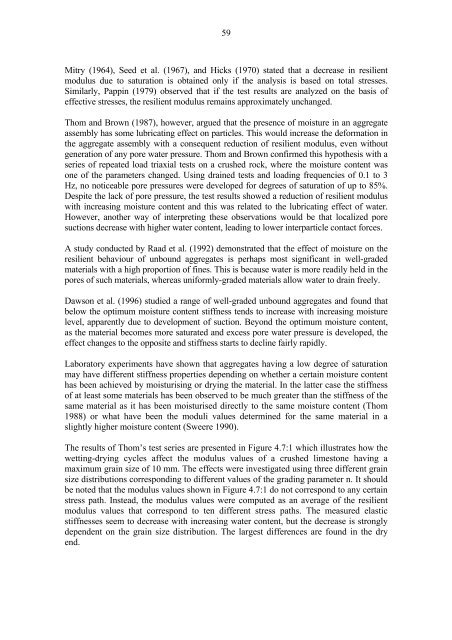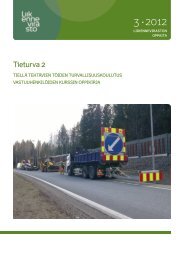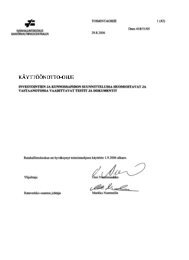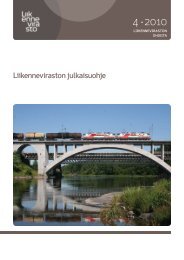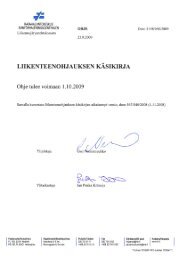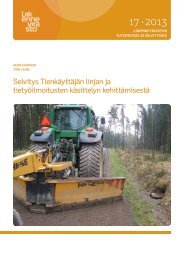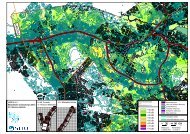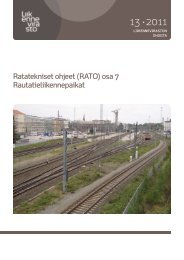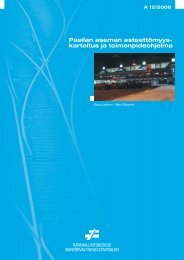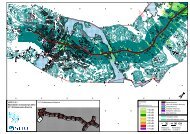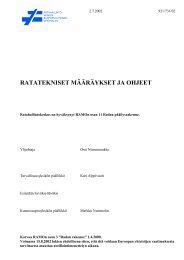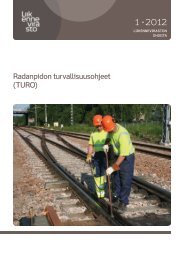Deformation behaviour of railway embankment ... - Liikennevirasto
Deformation behaviour of railway embankment ... - Liikennevirasto
Deformation behaviour of railway embankment ... - Liikennevirasto
You also want an ePaper? Increase the reach of your titles
YUMPU automatically turns print PDFs into web optimized ePapers that Google loves.
59<br />
Mitry (1964), Seed et al. (1967), and Hicks (1970) stated that a decrease in resilient<br />
modulus due to saturation is obtained only if the analysis is based on total stresses.<br />
Similarly, Pappin (1979) observed that if the test results are analyzed on the basis <strong>of</strong><br />
effective stresses, the resilient modulus remains approximately unchanged.<br />
Thom and Brown (1987), however, argued that the presence <strong>of</strong> moisture in an aggregate<br />
assembly has some lubricating effect on particles. This would increase the deformation in<br />
the aggregate assembly with a consequent reduction <strong>of</strong> resilient modulus, even without<br />
generation <strong>of</strong> any pore water pressure. Thom and Brown confirmed this hypothesis with a<br />
series <strong>of</strong> repeated load triaxial tests on a crushed rock, where the moisture content was<br />
one <strong>of</strong> the parameters changed. Using drained tests and loading frequencies <strong>of</strong> 0.1 to 3<br />
Hz, no noticeable pore pressures were developed for degrees <strong>of</strong> saturation <strong>of</strong> up to 85%.<br />
Despite the lack <strong>of</strong> pore pressure, the test results showed a reduction <strong>of</strong> resilient modulus<br />
with increasing moisture content and this was related to the lubricating effect <strong>of</strong> water.<br />
However, another way <strong>of</strong> interpreting these observations would be that localized pore<br />
suctions decrease with higher water content, leading to lower interparticle contact forces.<br />
A study conducted by Raad et al. (1992) demonstrated that the effect <strong>of</strong> moisture on the<br />
resilient <strong>behaviour</strong> <strong>of</strong> unbound aggregates is perhaps most significant in well-graded<br />
materials with a high proportion <strong>of</strong> fines. This is because water is more readily held in the<br />
pores <strong>of</strong> such materials, whereas uniformly-graded materials allow water to drain freely.<br />
Dawson et al. (1996) studied a range <strong>of</strong> well-graded unbound aggregates and found that<br />
below the optimum moisture content stiffness tends to increase with increasing moisture<br />
level, apparently due to development <strong>of</strong> suction. Beyond the optimum moisture content,<br />
as the material becomes more saturated and excess pore water pressure is developed, the<br />
effect changes to the opposite and stiffness starts to decline fairly rapidly.<br />
Laboratory experiments have shown that aggregates having a low degree <strong>of</strong> saturation<br />
may have different stiffness properties depending on whether a certain moisture content<br />
has been achieved by moisturising or drying the material. In the latter case the stiffness<br />
<strong>of</strong> at least some materials has been observed to be much greater than the stiffness <strong>of</strong> the<br />
same material as it has been moisturised directly to the same moisture content (Thom<br />
1988) or what have been the moduli values determined for the same material in a<br />
slightly higher moisture content (Sweere 1990).<br />
The results <strong>of</strong> Thom’s test series are presented in Figure 4.7:1 which illustrates how the<br />
wetting-drying cycles affect the modulus values <strong>of</strong> a crushed limestone having a<br />
maximum grain size <strong>of</strong> 10 mm. The effects were investigated using three different grain<br />
size distributions corresponding to different values <strong>of</strong> the grading parameter n. It should<br />
be noted that the modulus values shown in Figure 4.7:1 do not correspond to any certain<br />
stress path. Instead, the modulus values were computed as an average <strong>of</strong> the resilient<br />
modulus values that correspond to ten different stress paths. The measured elastic<br />
stiffnesses seem to decrease with increasing water content, but the decrease is strongly<br />
dependent on the grain size distribution. The largest differences are found in the dry<br />
end.


